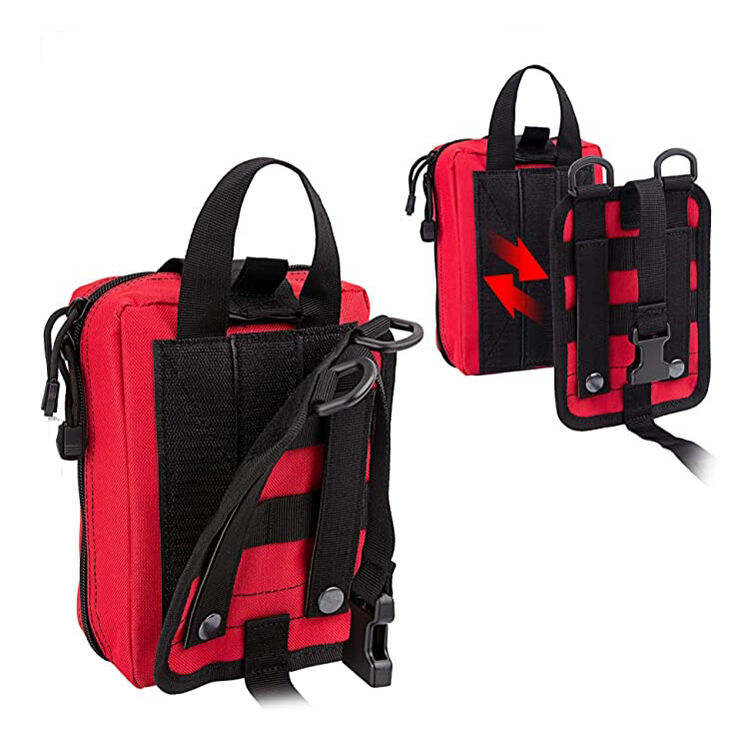The past few years saw the Individual First Aid Kits (IFAKs) become an essential item to both military men and people who enjoy carrying every-day carry (EDC) items. These kits prove to be a must in terms of offering first aid care in times of an emergency. Since there is an increasing demand of multi-purpose and effective IFAK pouches, manufacturers are coming up with creative designs that address the stringent requirements in tactical activities and individual preparedness. This paper discusses some of the new developments in tactical IFAK pouches, in particular on MOLLE-compatible ones in contrast to drop-legs and the use of high-durability materials.

MOLLE Compatibility vs. Drop-Leg Designs: Pros and Cons
The most important kind of decision made when it comes to picking an IFAK pouch are decisions between designs that are compatible with MOLLE and drop-leg designs. They both are unique in their own way, and the advantage usually depends on the need of the user.
MOLLE Compatibility
Modern load carrying equipment in the army has taken the form of MOLLE (Modular Lightweight Load-carrying Equipment). They main strength is their modularity as all of them can be attached to and detached off tactical vest, backpack or a belt swiftly using pouches. This versatility allows them to tailor their loadouts to suit their missions or day to day needs. The MOLLE compatible IFAK pouches are smaller and discrete in general thus they are perfect to keep a low profile.
The negative side is that reaching a MOLLE-mounted IFAK can be cumbersome under some conditions as in, high-stress events, or when having many layers of equipment on. Also, the process of attachment needs time when one is not familiar with the system.
Drop-Leg Designs
Drop-leg IFAK pouches on the other hand provide easy access since they are placed on the thigh. The benefits of this design are especially useful in the hands of medics and people that need fast access to medical supplies. Drop-leg pouches are also characterized by the straps and easy-release buckles that would give you the opportunity of adjusting and also securing it.
On the negative side, this drop-leg design may prove unfavorable when used over a prolonged period or when one is involved in a vigorous activity. It can inhibit movement or make extra noise because of its low positioning of the body. Nonetheless, a drop-leg style is also popular among people, who want to have quick access.
Conclusively, one should choose between MOLLE and drop-leg design based on his/her comfort and accessibility and the environment that one is likely to face during his operation.
High-Durability Materials in Modern IFAK Pouches
Harsh conditions of the modern battlefield and severe conditions outside require IFAK delivery pouches to be manufactured using resistant materials. As a result, another major trend of the progress of these necessary tools is the usage of materials of high durability.
Nylon and Cordura
Nylon and Cordura are among the most frequent materials. Both the materials are very good in resistance and tensile strength hence the pouches do not tear easily even when there is rough treatment. Moreover, these fabrics are quite light, and it is a good compromise between sturdiness and functionality.
Ripstop Fabric
One more material that is sweeping through the IFAK pouch market is ripstop. Famous due to its capacity not to make tears spread, ripstop is a perfect option in terms of tactical usage. Its grid-like structure makes it even stronger as well as protects it against the influences of nature and the weather (rain, dust).

Reinforced Stitching and Water-Resistant Coatings
In addition to the underlying fabric, companies are now paying more attention to the reinforced stitching, which would also contribute to the increased durability of IFAK pouches. Bar-tack reinforcement, as well as triple-stitching, is becoming a thing to make sure that the seams can withhold the pressure. Also, till now, most of the pouches are being provided with water-proof coating, which saves the contents of the pouches against moisture and other factors, hence maintain the quality of the medical supplies.
Conclusion
With the ongoing development and change of the tactical equipment, the forms and the materials of IFAK pouches also grow. Depending on a modular versatility of MOLLE systems or a fast access of drop-leg designs, a user may find a solution corresponding to his/her mission requirements and personal needs. In addition, material science has resulted in pouches able to resist the demands of both military and civilian life, provide strength, reliability and durability.
Such trends are significant to individuals who have a share in military or EDC preparedness so that whenever an emergency may occur, one may be able to face it with the best and most efficient tools. With innovations being made by the manufacturers, it is inevitable that the IFAK pouches are going to become even more essential in the pursuit of readiness and safety.
 EN
EN
 FR
FR
 DE
DE
 IT
IT
 JA
JA
 KO
KO
 RU
RU
 ES
ES
 AR
AR
 BG
BG
 HR
HR
 DA
DA
 NL
NL
 FI
FI
 EL
EL
 NO
NO
 PL
PL
 PT
PT
 RO
RO
 SV
SV
 TL
TL
 ID
ID
 SR
SR
 UK
UK
 VI
VI
 SQ
SQ
 TH
TH
 TR
TR
 AF
AF
 MS
MS
 CY
CY
 IS
IS
 HY
HY
 AZ
AZ
 KA
KA
 MN
MN
 MY
MY
 KK
KK
 UZ
UZ
 CS
CS



